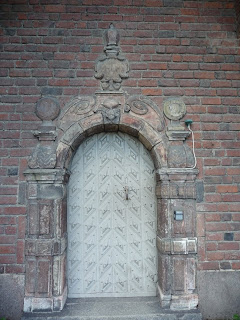Sunday, after careful calculation, we bought a Stockholm Card, good for 24 hours of transportation, museum and other admissions, and headed to the Gamla Stan, the old city. Stockholm is comprised of 14 islands in a lake that opens to the sea. Gamla Stan is the oldest of these and the site of the Royal Palace, which is still used for state and royal events. We toured the palace, the royal apartments, the royal treasury, the royal armory, the royal gift shoppe, all interesting, if not overwhelming. The highlight of the palace tour was the changing of the guard, which took place at 1:15 (and for an hour or so more; the band played on...).
From Gamla Stan and environs, and after walking some of the old streets, we headed to the Stockholm City Hall. City halls are important buildings in the Scandinavian and Germanic countries, and nothing beats Stockholm's. It is not nearly a century old, but is well known for its setting, its size, its tower, its Italian/piazza lay-out, and most of all, for hosting the Nobel Prize banquet every December 10th (Nobel's birthday). (Dyn-o-mite!) The English tour was very good. It is also a working city hall, with administrative offices all about, council chambers, and the rest. And, nearly unique among city halls of my experience, it even has a sizable gift store.
From the City Hall, we crossed town to the Vasa Museet. Early in the 1600's, to conduct a war with Poland, the Swedes built a giant warship, the Vasa, largest of its day (think Elizabethan; more than 200 feet long). Unfortunately, it had design problems, so to speak. It was launched, provisioned, manned, and sailed exactly 1300 meters before catching a breeze, capsizing, and sinking in the harbor. There were various attempts at raising the Vasa, but eventually it was forgotten. 300 years passed. In the early 1960s, through the persistence of one man, the ship was found, and, with 20th century engineering, raised. The Baltic is really a very big lake, brackish at best, and sea worms do not devour the wood as in other places. So the Vasa that was raised was very largely intact (even the sails and rope and clothing). Much conservation, and a little restoration occurred, and the ship is now on display at the Vasa Museet. It is, simply, one of those things one has to see to believe. Its size alone is fairly staggering. The amount of wood carving all over the vessel is no less impressive. (It was designed to impress the enemy). No pictures can do justice to this sight. But I tried.
From the Vasa we raced back across town to the vicinity of City Hall again to catch the last historical canal tour of the day, a one-hour narrated voyage that we were glad we did not have to pay for. Interestingly, it took us right by Langholmen, the island on which our “campground” is located. Also the national prison, now a youth hostel. (Bringing back memories of my 1982 Columbus Monthly article on potential uses for the Old Ohio Pen). The Swedes are so smart. Despite the boat ride, subway, buses and trams, we still logged 22,000 steps on the old pedometer.

Palace frontal view

Entry to royal chapel

Pix are not allowed in the Palace, but I could not resist this one, in the Treasury, of costumes the royal kids dressed up in back in the early 20th; from British Columbia

King for a Day






















































